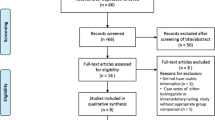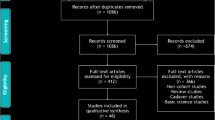Abstract
Purpose
Locked plate (LP) and retrograde intramedullary nail (RIN) are the most commonly used treatment options for periprosthetic femur fracture above total knee arthroplasty (TKA). Controversy still exists regarding which is better. Therefore we performed a meta-analysis to compare their clinical results.
Methods
A comprehensive search was conducted through PubMed, EMBase and the Cochrane Collaboration Library. Six comparative studies (265 patients) were included for the meta-analysis.
Results
No statistically significant differences were found between the LP group and RIN group in terms of six month union rate (OR, 1.19; 95 % CI, 0.52–2.69; P = 0.68), union time (WMD, 0.22; 95 % CI, −0.41 to 0.84; P = 0.50), operation time (WMD, 0.54; 95 % CI, −13.09 to 14.17; P = 0.94) or complication rate (OR, 0.79; 95 % CI, 0.22–2.91; P = 0.73). The LP fixation may have a relatively higher re-operation rate (OR, 5.17; 95 % CI, 1.02–26.27; P = 0.05) compared with RIN. The mean union time was 4.0 months in the LP group and 3.7 months in the RIN group.
Conclusion
This meta-analysis found no statistically significant difference in six month union rate, union time, operation time and complication rate between the LP group and RIN group. The RIN fixation may have a potential of lower re-operation rate compared with LP. The mean union time was 4.0 months in the LP group and 3.7 months in the RIN group.





Similar content being viewed by others
References
Dennis DA (2001) Periprosthetic fractures following total knee arthroplasty. Instr Course Lect 50:379
Bezwada HP, Neubauer P, Baker J, Israelite CL, Johanson NA (2004) Periprosthetic supracondylar femur fractures following total knee arthroplasty. J Arthroplast 19(4):453
Rorabeck CH, Taylor JW (1999) Periprosthetic fractures of the femur complicating total knee arthroplasty. Orthop Clin North Am 30(2):265
Sisto DJ, Lachiewicz PF, Insall JN (1985) Treatment of supracondylar fractures following prosthetic arthroplasty of the knee. Clin Orthop Relat Res (196):265
Herrera DA, Kregor PJ, Cole PA, Levy BA, Jonsson A, Zlowodzki M (2008) Treatment of acute distal femur fractures above a total knee arthroplasty: systematic review of 415 cases (1981–2006). Acta Orthop 79(1):22
Merkel KD, Johnson EW Jr (1986) Supracondylar fracture of the femur after total knee arthroplasty. J Bone Joint Surg Am 68(1):29
Moran MC, Brick GW, Sledge CB, Dysart SH, Chien EP (1996) Supracondylar femoral fracture following total knee arthroplasty. Clin Orthop Relat Res 324:196
Althausen PL, Lee MA, Finkemeier CG, Meehan JP, Rodrigo JJ (2003) Operative stabilization of supracondylar femur fractures above total knee arthroplasty: a comparison of four treatment methods. J Arthroplast 18(7):834
Meneghini RM, Keyes BJ, Reddy KK, Maar DC (2014) Modern retrograde intramedullary nails versus periarticular locked plates for supracondylar femur fractures after total knee arthroplasty. J Arthroplast 29(7):1478
Kancherla VK, Nwachuku CO (2014) The treatment of periprosthetic femur fractures after total knee arthroplasty. Orthop Clin North Am 45(4):457
Platzer P, Schuster R, Aldrian S, Prosquill S, Krumboeck A, Zehetgruber I, Kovar F, Schwameis K, Vecsei V (2010) Management and outcome of periprosthetic fractures after total knee arthroplasty. J Trauma 68(6):1464
Bong MR, Egol KA, Koval KJ, Kummer FJ, Su ET, Iesaka K, Bayer J, Di Cesare PE (2002) Comparison of the LISS and a retrograde-inserted supracondylar intramedullary nail for fixation of a periprosthetic distal femur fracture proximal to a total knee arthroplasty. J Arthroplast 17(7):876
Makinen TJ, Dhotar HS, Fichman SG, Gunton MJ, Woodside M, Safir O, Backstein D, Willett TL, Kuzyk PR (2015) Periprosthetic supracondylar femoral fractures following knee arthroplasty: a biomechanical comparison of four methods of fixation. Int Orthop
Kilucoglu OI, Akgul T, Saglam Y, Yazicioglu O (2013) Comparison of locked plating and intramedullary nailing for periprosthetic supracondylar femur fractures after knee arthroplasty. Acta Orthop Belg 79(4):417
Aldrian S, Schuster R, Haas N, Erhart J, Strickner M, Blutsch B, Wernhart S, Leitgeb J, Platzer P (2013) Fixation of supracondylar femoral fractures following total knee arthroplasty: is there any difference comparing angular stable plate fixation versus rigid interlocking nail fixation? Arch Orthop Trauma Surg 133(7):921
Horneff JG 3rd, Scolaro JA, Jafari SM, Mirza A, Parvizi J, Mehta S (2013) Intramedullary nailing versus locked plate for treating supracondylar periprosthetic femur fractures. Orthopedics 36(5), e561
Hou Z, Bowen TR, Irgit K, Strohecker K, Matzko ME, Widmaier J, Smith WR (2012) Locked plating of periprosthetic femur fractures above total knee arthroplasty. J Orthop Trauma 26(7):427
Large TM, Kellam JF, Bosse MJ, Sims SH, Althausen P, Masonis JL (2008) Locked plating of supracondylar periprosthetic femur fractures. J Arthroplast 23(6 Suppl 1):115
Wick M, Muller EJ, Kutscha-Lissberg F, Hopf F, Muhr G (2004) Periprosthetic supracondylar femoral fractures: LISS or retrograde intramedullary nailing? Problems with the use of minimally invasive technique. Unfallchirurg 107(3):181
Su ET, DeWal H, Di Cesare PE (2004) Periprosthetic femoral fractures above total knee replacements. J Am Acad Orthop Surg 12(1):12
Streubel PN, Ricci WM, Wong A, Gardner MJ (2011) Mortality after distal femur fractures in elderly patients. Clin Orthop Relat Res 469(4):1188
Bhattacharyya T, Chang D, Meigs JB, Estok DM 2nd, Malchau H (2007) Mortality after periprosthetic fracture of the femur. J Bone Joint Surg Am 89(12):2658
Kolb W, Guhlmann H, Windisch C, Marx F, Koller H, Kolb K (2010) Fixation of periprosthetic femur fractures above total knee arthroplasty with the less invasive stabilization system: a midterm follow-up study. J Trauma 69(3):670
Nauth A, Ristevski B, Begue T, Schemitsch EH (2011) Periprosthetic distal femur fractures: current concepts. J Orthop Trauma 25(Suppl 2):S82
Chettiar K, Jackson MP, Brewin J, Dass D, Butler-Manuel PA (2009) Supracondylar periprosthetic femoral fractures following total knee arthroplasty: treatment with a retrograde intramedullary nail. Int Orthop 33(4):981
Han HS, Oh KW, Kang SB (2009) Retrograde intramedullary nailing for periprosthetic supracondylar fractures of the femur after total knee arthroplasty. Clin Orthop Surg 1(4):201
Rorabeck CH, Angliss RD, Lewis PL (1998) Fractures of the femur, tibia, and patella after total knee arthroplasty: decision making and principles of management. Instr Course Lect 47:449
Rorabeck CH, Taylor JW (1999) Classification of periprosthetic fractures complicating total knee arthroplasty. Orthop Clin North Am 30(2):209
Neer CS 2nd, Grantham SA, Shelton ML (1967) Supracondylar fracture of the adult femur. A study of one hundred and ten cases. J Bone Joint Surg Am 49(4):591
Marsh JL, Slongo TF, Agel J, Broderick JS, Creevey W, DeCoster TA, Prokuski L, Sirkin MS, Ziran B, Henley B, Audige L (2007) Fracture and dislocation classification compendium—2007: orthopaedic trauma association classification, database and outcomes committee. J Orthop Trauma 21(10 Suppl):S1
Conflict of interest
None
Author information
Authors and Affiliations
Corresponding author
Rights and permissions
About this article
Cite this article
Li, B., Gao, P., Qiu, G. et al. Locked plate versus retrograde intramedullary nail for periprosthetic femur fractures above total knee arthroplasty: a meta-analysis. International Orthopaedics (SICOT) 40, 1689–1695 (2016). https://doi.org/10.1007/s00264-015-2962-9
Received:
Accepted:
Published:
Issue Date:
DOI: https://doi.org/10.1007/s00264-015-2962-9




